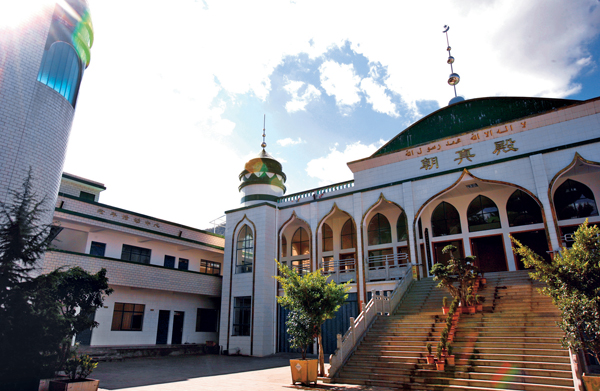Zhiwa Mosque (芝华清真寺) is an important Hui Muslim religious site located in Fengyi Town (凤仪镇), Dali City (大理市), Yunnan Province (云南省). Originally built during the Hongwu reign of the Ming Dynasty, the existing complex includes the main gate, second gate (known as the “worship tower”), the main prayer hall, and two side buildings. The second gate features an octagonal bracketed eave structure, while the main prayer hall spans 19.2 meters in width and 13 meters in depth. The mosque underwent major renovation in the 33rd year of the Guangxu reign (1907) and an expansion in 1983. Together with the nearby Baiwangcheng Ruins (白王城遗址) and Fazang Temple (法藏寺), it forms part of Fengyi Town’s diverse cultural heritage landscape. As a religious site, its daily management includes fire safety and patriotic education. The registered Hui Muslim community currently includes 396 households totaling 1,490 individuals.
- Initial Construction: Ming Dynasty, Hongwu reign
- Major Renovation: 1907 (Guangxu 33rd year, Qing Dynasty)
- Expansion: 1983
- Location: Fengyi Town (凤仪镇), Dali City (大理市), Yunnan Province (云南省)
- Main Prayer Hall Dimensions: 5-bay layout, 19.2 meters wide, 13 meters deep
- Architectural Feature: Octagonal bracketed structure on the second and third floors of the worship tower
Historical Background
Zhiwa Mosque (芝华清真寺) was first built during the Hongwu reign of the Ming Dynasty (exact year unknown). It underwent a large-scale renovation in 1907 during the Guangxu reign of the Qing Dynasty and was expanded in 1983, forming the layout seen today. Existing inscriptions and structural features attest to its more than 600 years of historical continuity.
Architectural Features
The mosque complex is arranged from south to north, consisting of:
- Main Gate, Second Gate, Prayer Hall, and Auxiliary Buildings
- The Second Gate is a three-story brick-and-wood structure, with octagonal bracket sets supporting the eaves on the second and third floors
- The Main Prayer Hall features a five-bay layout, with a total width of 19.2 meters and a depth of 13 meters; the roof is designed in the traditional hip-and-gable (xie shan) style
- The South Courtyard includes two-story side buildings, forming a traditional siheyuan (四合院, courtyard residence) layout with the main structures
Religious and Community Functions
As the central religious site for Hui Muslims in Fengyi Town (凤仪镇), the mosque supports both worship and cultural education:
- A bulletin system in the courtyard displays religious policies and messages promoting ethnic unity
- As of 2019, the mosque’s religious activities operate under the guidance of the local United Front Work Department, with a formal fire safety management system in place
- The historically established community remains active, with a current registered population of 1,490 Hui Muslims
Cultural Significance
Zhiwa Mosque (芝华清真寺) carries rich cultural and architectural value:
- Its structures integrate construction techniques from the Ming and Qing dynasties, with bracket designs typical of western Yunnan styles
- Alongside the Baiwangcheng Ruins (白王城遗址) and local Confucian temples, it contributes to a multiethnic cultural heritage network in Fengyi Town
- As one of the few mosques retaining the original Ming Dynasty layout, it serves as an important case study for understanding the architectural evolution of Hui Muslim religious sites in Yunnan (云南)

 7 Days GolfingTour
7 Days GolfingTour
 8 Days Group Tour
8 Days Group Tour
 8 Days Yunnan Tour
8 Days Yunnan Tour
 7 Days Shangri La Hiking
7 Days Shangri La Hiking
 11 Days Yunnan Tour
11 Days Yunnan Tour
 6 Days Yuanyang Terraces
6 Days Yuanyang Terraces
 11 Days Yunnan Tour
11 Days Yunnan Tour
 8 Days South Yunnan
8 Days South Yunnan
 7 Days Tea Tour
7 Days Tea Tour
 8 Days Muslim Tour
8 Days Muslim Tour
 12 Days Self-Driving
12 Days Self-Driving
 4 Days Haba Climbing
4 Days Haba Climbing
 Tiger Leaping Gorge
Tiger Leaping Gorge
 Stone Forest
Stone Forest
 Yunnan-Tibet
Yunnan-Tibet
 Hani Rice Terraces
Hani Rice Terraces
 Kunming
Kunming
 Lijiang
Lijiang
 Shangri-la
Shangri-la
 Dali
Dali
 XishuangBanna
XishuangBanna
 Honghe
Honghe
 Kunming
Kunming
 Lijiang
Lijiang
 Shangri-la
Shangri-la
 Yuanyang Rice Terraces
Yuanyang Rice Terraces
 Nujiang
Nujiang
 XishuangBanna
XishuangBanna
 Spring City Golf
Spring City Golf
 Snow Mountain Golf
Snow Mountain Golf
 Stone Mountain Golf
Stone Mountain Golf














